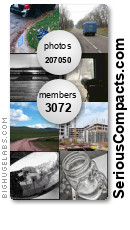People sometimes say that all digital images look the same. I don't think they're referring to noise versus grain, the large DOF of small sensor cameras, or the tendency many of us have to overprocess our images. These are all issues that affect the usual "digital look," but color and distribution of tones are closer to the heart of the matter. On the one hand, each company has a characteristic way to do color and contrast, and this is apparent in the look of in-camera JPEGs. In this way, the "look" imparted by an in-camera image processing engine is a bit like a film stock. Each camera brand has a characteristic way of handling color and contrast, and often I can spot the images from one versus another. Yet, as anyone who has ever shot film knows, the differences between different film stocks are far more distinct than the differences between in-camera image processing engines. It seems that with digital cameras, each company is going for a similar basic look. With film stocks, each company has gone for something unique.
A number of folks with considerable experience shooting film and good Photoshop skills have been able to simulate the look of their favorite films through postprocessing. Petteri has a very nice writeup of his thoughts and experiences in this area. He was also kind enough to share his curves via a download link at the end of the article. Yet many simply don't have the film experience to know which stocks they like. Some of us don't even know what look we want until we see it. That's where Alien Skin's Exposure comes in. Exposure allows us to apply the look of a film stock of choice to our images. There are tons of color and black and white film stocks to choose from. For those of us who don't know much about the look of these films, it allows us to preview the image with any given film simulation. For those who know a bit about processing, there are some great tools included for customizing color and contrast settings from the defaults for a given film stock, and it is simple to save these customized simluations for repeat use at a later time. There are plenty of Exposure reviews online, and my purpose with this post isn't to do another one. My point is simply to say that Exposure has completely changed the way I process. I now convert from RAW with a goal of creating a flat contrast image with true colors, and nearly every resulting image goes through Exposure. Often I don't even know how I want an image to look until I start applying a variety of simulations. I'll go through each in turn until one just looks right. At $249, it's an expensive product, but worth the asking price to me. I'm still using version 1.5 because I'm more than happy with the results and don't want to pay the $149 upgrade price. For anyone whose postprocessing results don't meet their needs, I can easily recommend Alien Skin Exposure.
Click here to view an animated GIF comparing a few of my favorite film simulations with the default colors from a C1 converted 5D image. The file is over 3MB in size, so it may take a while to load.
Losing the Digital Look
Sunday, November 25, 2007
Posted by Amin
![]() Labels:
Alien Skin Exposure
Labels:
Alien Skin Exposure
Losing the Digital Look
2007-11-25T19:21:00-05:00
Amin
Alien Skin Exposure|
Subscribe to:
Post Comments (Atom)

